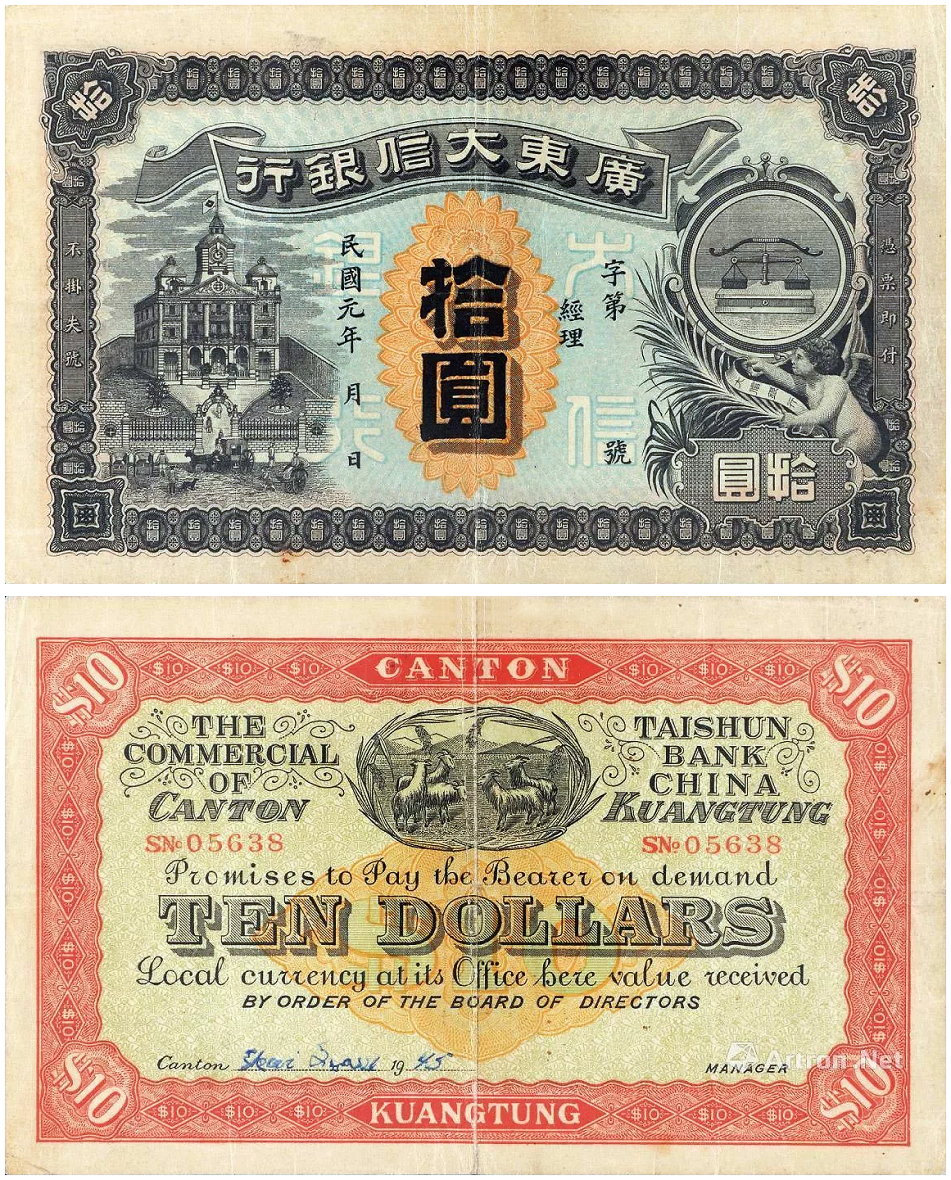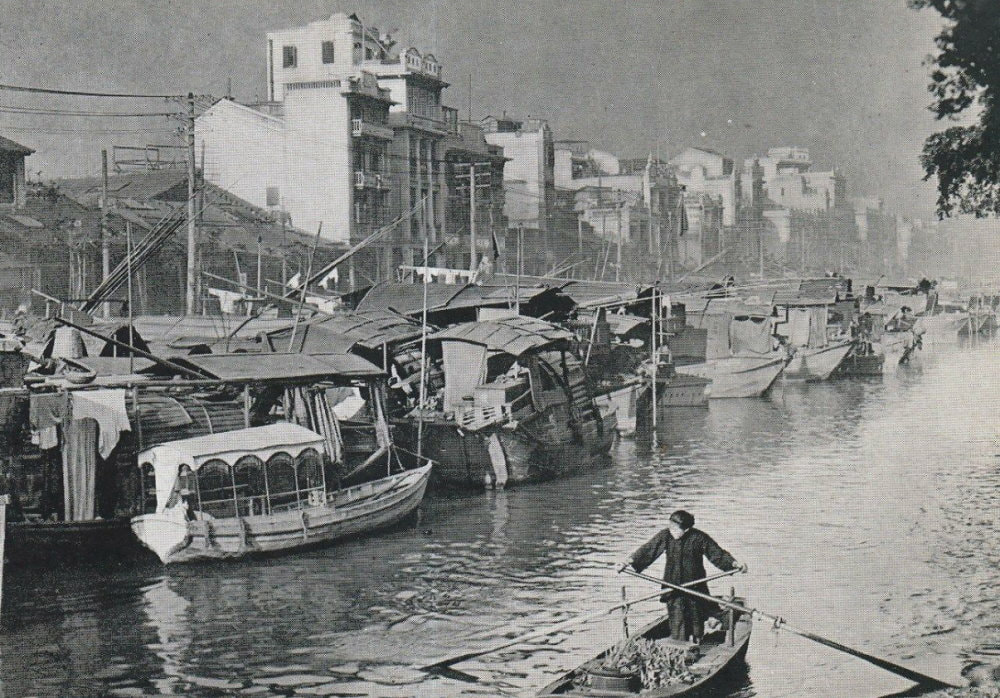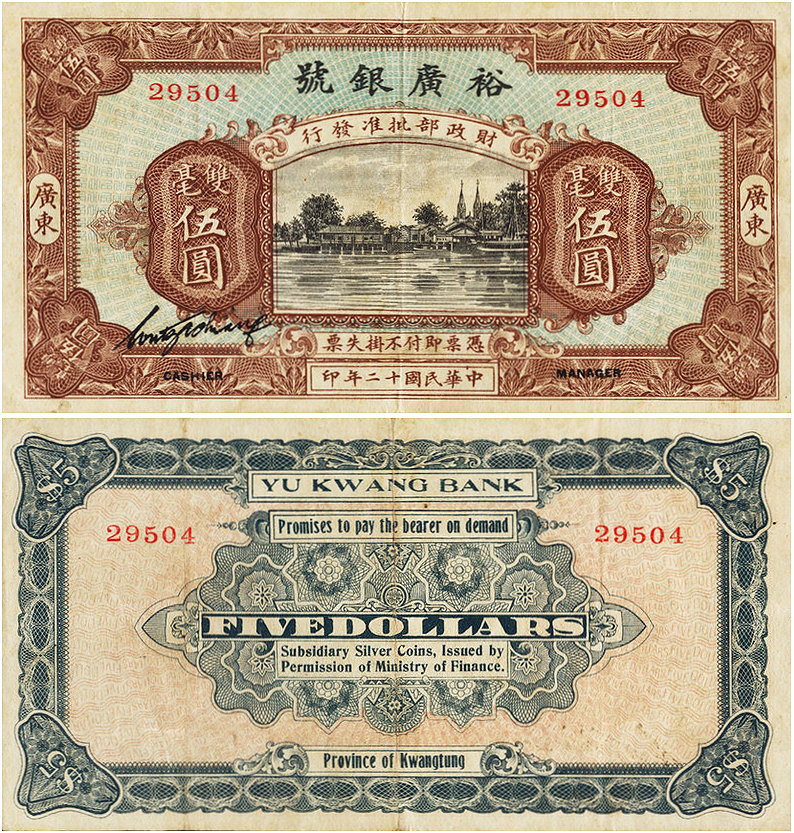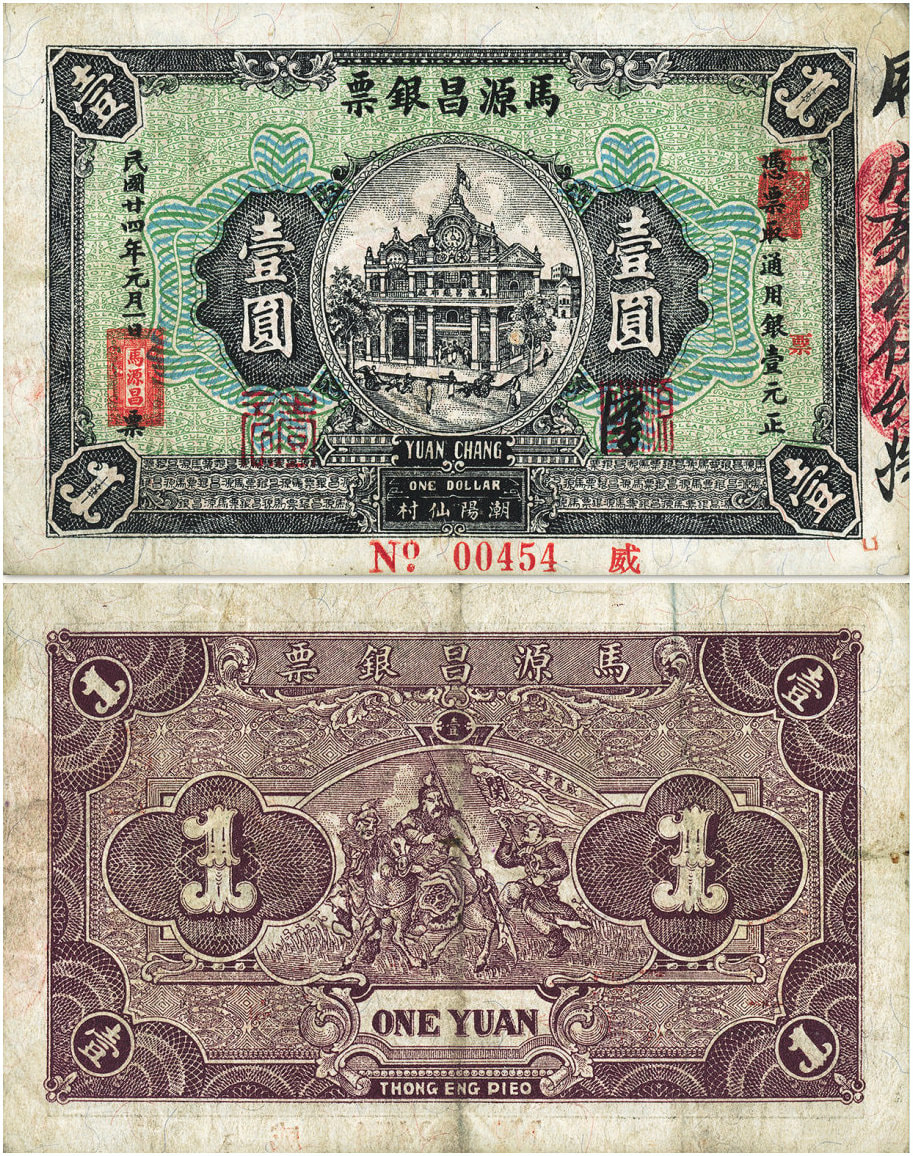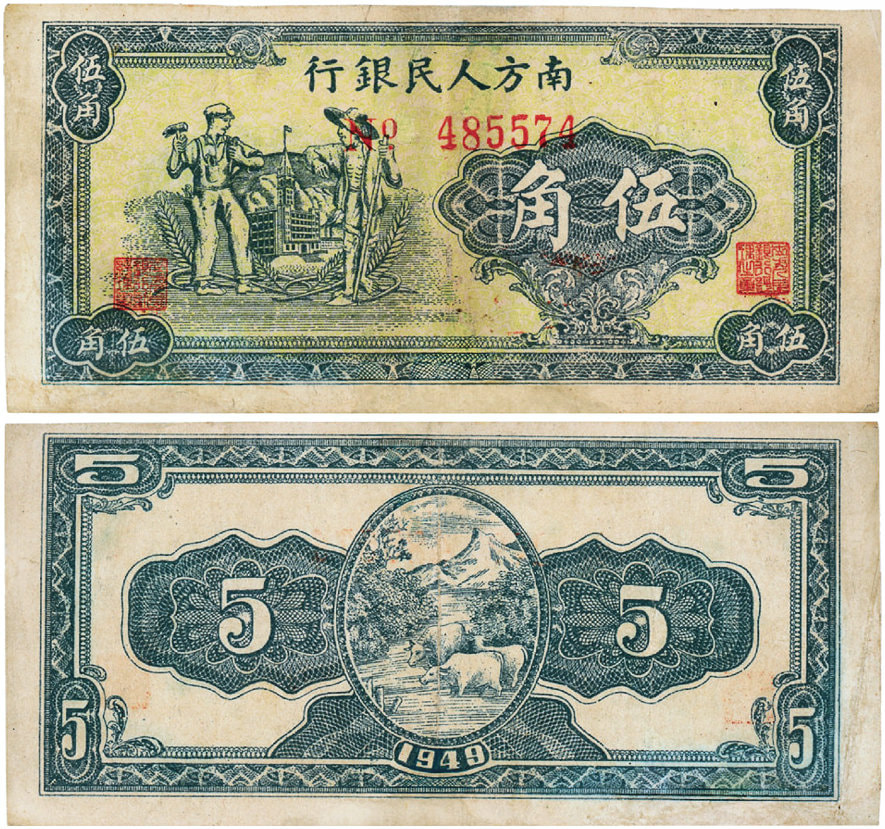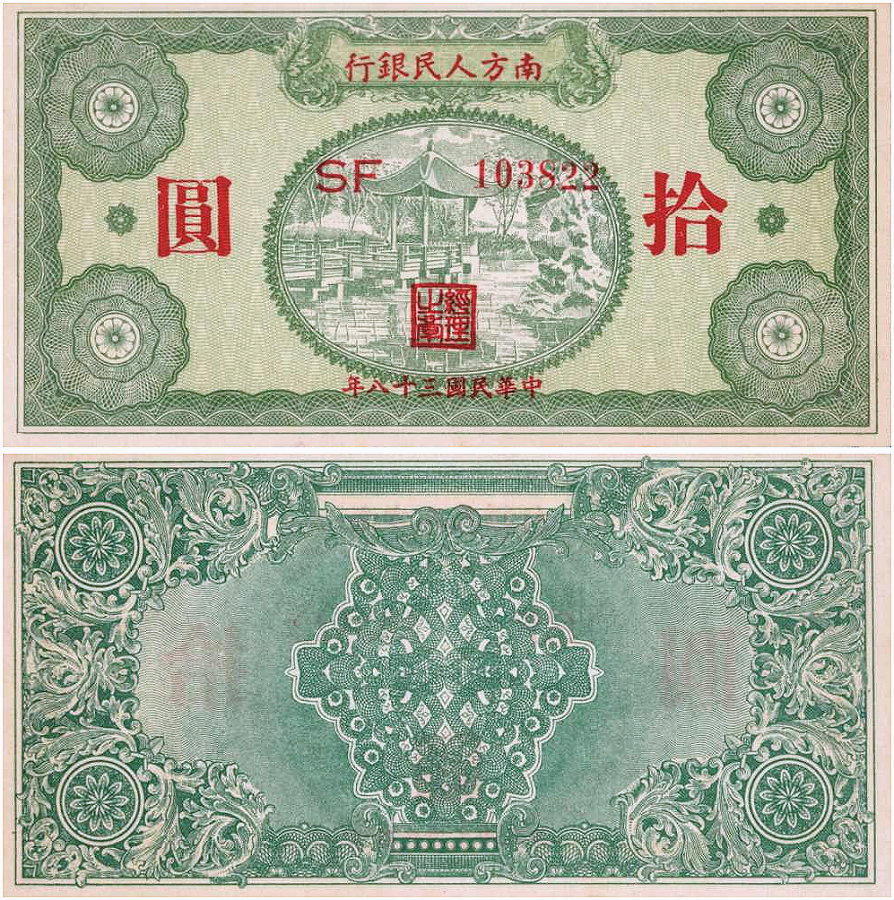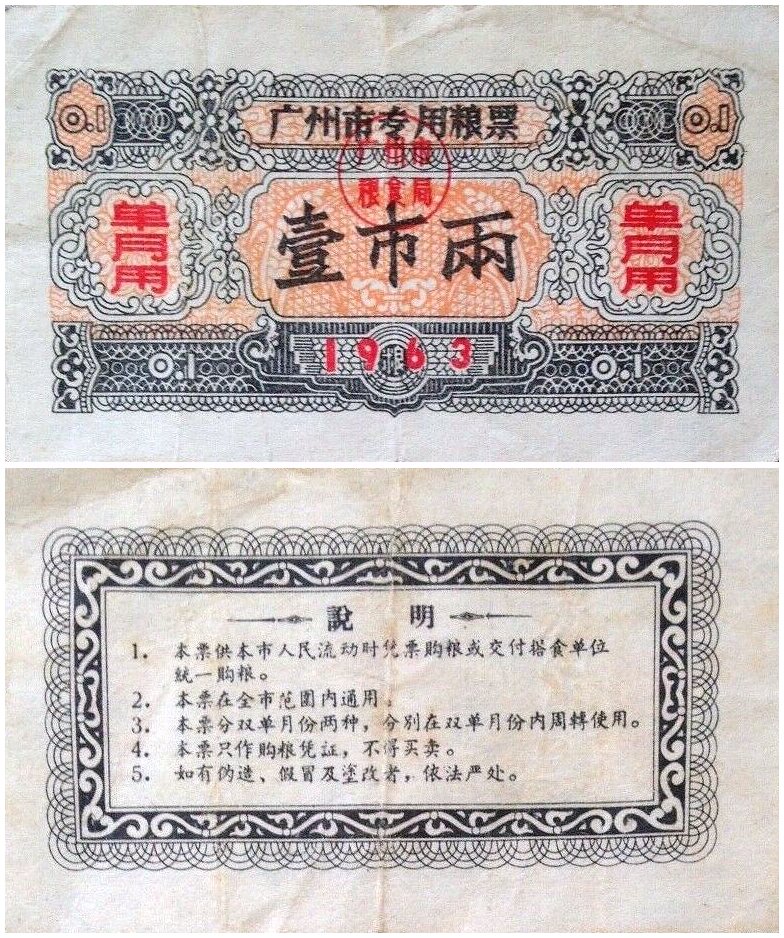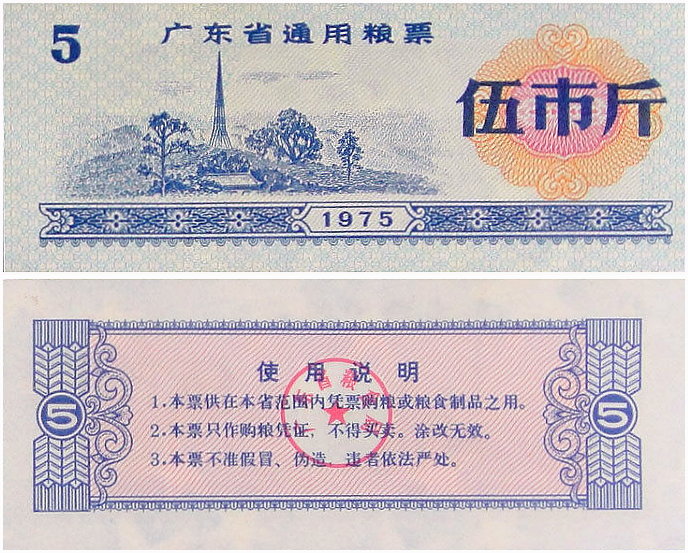Canton/Guangzhou - 廣州
|
New Created May 06 2019
|
This page focuses mainly on commerical and Japanese occupation issues.
Kee Kwan Motor Road Co. - 岐關車路有限公司
|
The Kee Kwan Motor Road Company was established in July 1927, to set up a transportation service in oder to develop business and promote Macau, along the route first created in 1894 to connect mainland Kwangtung with Macau. The inaugural run of the new service occurred on March 18th 1927. The 'Senha de passagem' text on the back beneath the title is Portuguese (Macau until 2000 was a Portuguese colony. This literally translates as 'password of passage'. The Company still exists as a state owned cargo and passenger transporter between Macao and the mainland. Right: Kee Kwan Motor Road Co. Ltd, 50 cents of 1933. Printed by the Hong Kong Banknote Company (香港钞票公司) This note is from a series which includes denominations of 5, 10, 20 and 50 cents. Only the 10 is catalogued in Smith & Matravers, as C85-1. |
The Kee Kwan Motor Company as described in the Macua Decennial Report, 1922-31 by A.J.Basto; Commissioner of Customs. Lappa, Macau, 1st December 1931:

"About 10 years ago there was a project to build a motor road between Macao and Shekkia (Shekki, a former Chinese city in Kwangtung/Guangdong Province, now the Shiqi Subdistrict of Zhongshan) of 8.37 miles distance in order to supply better and shorter communication by land through the Chungshan district between the two places. Owing to the disturbed condition of the country and to the difficulty of raising sufficient funds, work could not be started for a long while. In November 1927 a Chinese company, styled Kee Kwan Highway Company, Ltd., conceived by the villagers through whose district the road was to pass was formed under the management of Mr. Cheng Tze-sheung, with a capital of $200,000 divided into 40,000 shares of $5 each.
The first stage of the road was formally opened to the public on the 18th March 1927, at a ceremony at which the Governors of Macao and Hongkong assisted, when a service of four motor-omnibuses began to ply between Macao and Tsuimi, a rich village at one time but now fallen into decay. For years the Portuguese authorities had favoured the construction of this road, which would aid the development of both Macao and Shekki alike. A monopoly for an unlimited period of time of all public vehicular traffic on the road has been secured from the Canton Government. The highway is 7 feet wide generally, in no place less than 24 feet, and has proved to be one of the best cross-country roads in the province of Kwangtung. At the end of 1931 this road had been extended as far as Saiah (Shenzhen area?), 13.19 miles from Macao, where a steel bridge, crossing the Taiwan river, is now under construction and which, according to the company's estimate, will be completed by the end of January 1932. As soon as the building of the bridge is finished, through traffic between Macao and Shekki will be open to the public. The Shelkki section of the highway has already been completed, and motor services are running there daily. A branch road, 3 miles long, connecting Hachak (Xiace), a stage of the highway, with Chung Shan Port (Zhongshan), and another one connecting Siukachuen with Samheung (Sanxiang), have been built also. There are about 80 omnibuses, 12 motor-trucks, and about 60 to 80 motor-cars passing this road daily, all belonging to the company. The annual licence issued by the government for a car using this road costs $60, and the company's annual licence $8. Besides these charges, the tolls levied by the company are from $2 to $6.50 for a single trip and from $3 to $9.50 for a return trip, according to distance and number of persons carried by each car."
The first stage of the road was formally opened to the public on the 18th March 1927, at a ceremony at which the Governors of Macao and Hongkong assisted, when a service of four motor-omnibuses began to ply between Macao and Tsuimi, a rich village at one time but now fallen into decay. For years the Portuguese authorities had favoured the construction of this road, which would aid the development of both Macao and Shekki alike. A monopoly for an unlimited period of time of all public vehicular traffic on the road has been secured from the Canton Government. The highway is 7 feet wide generally, in no place less than 24 feet, and has proved to be one of the best cross-country roads in the province of Kwangtung. At the end of 1931 this road had been extended as far as Saiah (Shenzhen area?), 13.19 miles from Macao, where a steel bridge, crossing the Taiwan river, is now under construction and which, according to the company's estimate, will be completed by the end of January 1932. As soon as the building of the bridge is finished, through traffic between Macao and Shekki will be open to the public. The Shelkki section of the highway has already been completed, and motor services are running there daily. A branch road, 3 miles long, connecting Hachak (Xiace), a stage of the highway, with Chung Shan Port (Zhongshan), and another one connecting Siukachuen with Samheung (Sanxiang), have been built also. There are about 80 omnibuses, 12 motor-trucks, and about 60 to 80 motor-cars passing this road daily, all belonging to the company. The annual licence issued by the government for a car using this road costs $60, and the company's annual licence $8. Besides these charges, the tolls levied by the company are from $2 to $6.50 for a single trip and from $3 to $9.50 for a return trip, according to distance and number of persons carried by each car."
Source: https://www.macaudata.com/macaubook/ebook003/html/1922-31.htm
|
In 1912, several Chinese residents of the US, including members of the Fok family, founded the Bank of Canton. It issued currency until 1935, during which year the bank failed; at the time it had branches in San Francisco, Bangkok, Shanghai, Canton and Hankow. In 1936, Dr. T.V. Soong reorganized the Bank and it reopened. The Bank of Canton incorporated a subsidiary on July 1, 1936 in Macau, making it one of the longest established banks in Macau. The bank continued in operation (outside of the mainland after 1950) until 1988 when it was taken over and renamed by the Security Pacific National Bank Right: not a banknote but a Bank of Canton bond of 1935 for 5$. Apparently issued in response to the failure of the bank and used to clear the debts before the Canton branch resumed business following reorganisation. Issued in denominations of 1, 5, 10, 50 and 100$ (yuan). Printed in Shanghai. |
The Taishun Commercial Bank of China - 广东大信银行
|
Very little information can be found for this bank. This c1912 series is found in denominations of $1, $5 and $10 (shown right). Signed and dated examples of the $1 and $5 are known. According to an online Chinese source, the bank was founded in 1909; the manager was Feng Shangyan. It circulated paper money during 1912-1915 and closed in 1920. Right: The Taishun Commercial Bank of China, 10 dollars of 1912, Canton (Smith & Matravers K 61-2). The place for the signature and completed year date on the back is usually found blank in surviving examples. Someone has added a signature of sorts in the day/month line and completed the year as 1945. Most likely this example was either obtained as a souvenier at this date and filled in for a joke by the purchaser - or somebody tried to pass it off as a still current note. |
|
Above: a boat lined Canton canal, c1930s
|
Above: a view across Central Canton in 1949
|
Various small-commercial issuers
'Nibingfa Bank' (新亨)倪炳发(镭票)
|
A small commercial issuer based in Swatow (Shantou), known to have circulated cash notes in 1927 and 1929. Sometimes referred to as the Nibingfa Bank or Ngai Ping Fat Bank, though it's not clear what kind of business this was. Possibly a money changer? Right: 50 cash issue of 1929. Below: part of Swatow (Shantou) port, with a covered pier or bridge, c1930. |
Japanese Occupation: Military Currency 軍用手票
The Japanese movement against Canton commenced in August 1937, with almost daily bombing campaigns, leading to the capture of a strategic island from which invasion would commence. Japan finally took control of Canton in October 1938, with reportedly little resistance, and surrounded Hong Kong. The latter city became swamped by refugees, and some businesses also relocated within the then still British controlled colony. Others civilians had fled to Macau, or into the Chinese countryside. Much of Canton had been torched by Chinese nationalists prior to Japanese capture.
|
Japanese Imperial Government - 軍用手票 - 大日本帝国政府 Bank of Japan types notes but with the reference to the Bank of Japan omitted. These are known to have mainly circulated in Jiangsu Province and southern areas of China including Canton (Guangzhou). Period reports indicate that the shoddily adapted notes (this and the cancelled Bank of Japan title type), which had been introduced to supplant the briefly circulated, antiquated style vertical military notes; only caused confusion and were poorly recieved by the public. Right: 5 Yen of c1939 (SCWPM M25), with a pair of circular South-China (Canton/Hong Kong) hentaigana/ hiragana counterstamps in violet. These stamps are found in various colours. Inevitably some are believed to be spurious. |
The Central Reserve Bank of China - 中央儲備銀行
The Japanese set up the Central Bank of China in Nanking (Nanjing) after they invaded southern China. This puppet bank was created in 1940-41 to serve the needs of the Japanese controlled Nanking regime of Wang Jingwei, self styled as the Republic of China. It is probably not coincidental that the name of the bank - The Central Reserve Bank of China - was that originally intended for the re-organised Central Bank of China following the Kuomintang Governments currency reforms of 1935. That scheme never transpired.
|
Right: The Central Reserve Bank of China 500 yuan of 1943 (1944), with Kwangtung Province issue overprints, (SCWPM J24c). The portrait is of Sun Yat-sen, and the back depicts his mausoleum at Nanking; such nationalistic Chinese imagery being a mostly failed attempt to encourage acceptance of this money among the disgruntled Chinese public. |
Communist and Peoples Republic of China related issues
Following the defeat and surrender of Japan in 1945, the peace was short lived. The uneasy and in some regions almost non-existent truce between the Nationalists and the Communists whilst they fought the Japanese, soon broke down. Despite American led efforts to prevent the resumption of the Civil War, it was not long before fighting broke out. Money played a key role in this period as it had during the conflict with Japan. Hyperinflation, growing poverty and inequality turned many against the Nationalist government.
Mainland China slowly fell under Communist forces, as Chiang Kai-shek and his government abandoned Nanking; first to Canton which briefly became the capital of Nationalist China, and then to Chungking. Canton was taken by the PLA (Peoples Liberation Army) on October 14; Chungking followed on November 30th. In December Chiang and the government finally abandoned the mainland, the capital was transferred to Taipei, Taiwan Province where it has remained ever since. Mao meanwhile declared the founding of the People's Republic of China, at Peking (Beijing) on October 1, 1949.
Mainland China slowly fell under Communist forces, as Chiang Kai-shek and his government abandoned Nanking; first to Canton which briefly became the capital of Nationalist China, and then to Chungking. Canton was taken by the PLA (Peoples Liberation Army) on October 14; Chungking followed on November 30th. In December Chiang and the government finally abandoned the mainland, the capital was transferred to Taipei, Taiwan Province where it has remained ever since. Mao meanwhile declared the founding of the People's Republic of China, at Peking (Beijing) on October 1, 1949.
Southern Peoples Bank 南方人民銀行
|
Right: Southern Peoples Bank 10 yuan of 1949 (SCWPM S3489). Some examples of the 10 yuan are found overprinted as a supposed provisional issue of the Fukien-Kwangtung-Kiangsi Border Area Bank, with the new title overprinted in black over the old, and a large red hammer and sickle overprinted on the reverse. It is believed by some that this is a recent fantasy alteration (the 10 yuan is very common unlike the rest of the issues of the Southern Peoples Bank). |
Food and commodities ration coupons:
The End


